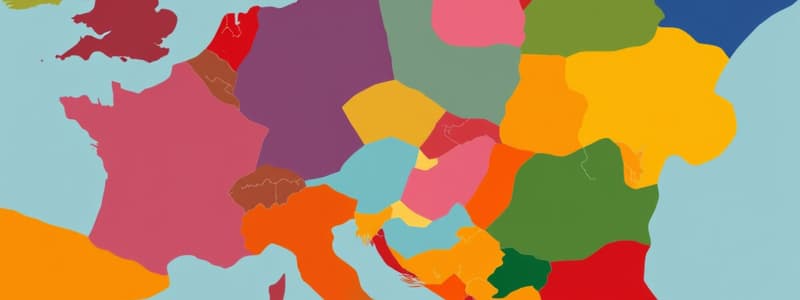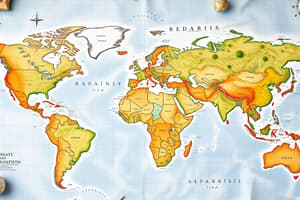Podcast
Questions and Answers
What are the key elements that make a map complete?
What are the key elements that make a map complete?
The key elements that make a map complete are the title, legend, scale, grid, and North line.
How does a scale on a map assist users?
How does a scale on a map assist users?
A scale on a map assists users by explaining the ratio of distances on the map to actual distances on the ground.
Explain the function of the North line on a map.
Explain the function of the North line on a map.
The North line on a map indicates the North direction, helping users locate other directions.
What is the purpose of the legend in a map?
What is the purpose of the legend in a map?
Why are maps considered easier to use compared to globes?
Why are maps considered easier to use compared to globes?
How do geographical grids benefit map users?
How do geographical grids benefit map users?
List one advantage of using maps for administrative purposes.
List one advantage of using maps for administrative purposes.
Why are maps important for travelers?
Why are maps important for travelers?
What are conventional symbols on maps?
What are conventional symbols on maps?
What types of symbols are used to represent geographical features on maps?
What types of symbols are used to represent geographical features on maps?
Describe the process of how a river forms meanders.
Describe the process of how a river forms meanders.
What is the difference between a tributary and a distributary?
What is the difference between a tributary and a distributary?
What is a delta and how is it formed?
What is a delta and how is it formed?
Explain the terms anticline and syncline.
Explain the terms anticline and syncline.
What creates block mountains?
What creates block mountains?
What are point symbols used for on a map?
What are point symbols used for on a map?
How do colors enhance the interpretability of maps?
How do colors enhance the interpretability of maps?
What is the significance of the river's source and mouth?
What is the significance of the river's source and mouth?
What is the main function of maps in geography?
What is the main function of maps in geography?
How does a sketch differ from a map?
How does a sketch differ from a map?
What is a globe, and how does it differ from a map?
What is a globe, and how does it differ from a map?
What is a plan, and how does it compare to a map?
What is a plan, and how does it compare to a map?
Define the scale of a map.
Define the scale of a map.
How would you calculate the ground distance given a map distance of 10 cm on a scale of 1:25,000?
How would you calculate the ground distance given a map distance of 10 cm on a scale of 1:25,000?
What type of scale would you use to get an accurate representation of very small distances?
What type of scale would you use to get an accurate representation of very small distances?
What are cardinal directions, and can you name them?
What are cardinal directions, and can you name them?
What purpose do conventional symbols serve in maps?
What purpose do conventional symbols serve in maps?
What is the difference between large-scale and small-scale maps?
What is the difference between large-scale and small-scale maps?
Explain what a representative fraction or ratio scale is.
Explain what a representative fraction or ratio scale is.
What information does a linear or graphic scale provide?
What information does a linear or graphic scale provide?
How can knowing the North direction aid in navigation?
How can knowing the North direction aid in navigation?
What is the significance of scale drawings in real life?
What is the significance of scale drawings in real life?
Flashcards are hidden until you start studying
Study Notes
Maps Overview
- Maps are two-dimensional representations of the Earth's surface, showing land and water features.
- They simplify geographical information, allowing for understanding of distances, directions, and the shapes of countries.
Elements of a Map
- Title: Identifies the purpose of the map, usually found at the top.
- Legend: Explains symbols used, which can include shapes, colors, and lines.
- Scale: Shows the ratio of map distances to actual ground distances (e.g., 1 cm on the map equals 100 km).
- North Line: Indicates the North direction for orienting the map.
- Grid: Comprises horizontal (latitudes) and vertical (longitudes) lines, facilitating exact location pinpointing.
Advantages of Maps
- Portable, allowing for easy transport and use.
- Detailed representation of urban layouts and various geographical areas.
- More informative than globes, particularly for specific topographical information.
- Easily updated to reflect changes in physical or political landscapes.
- Useful for various professionals like sailors, pilots, engineers, and urban planners.
- Employed by governments for administrative, planning, and defense.
Importance of Maps
- Represent the real world on a reduced scale, aiding in navigation and travel.
- Organize geographical data, illustrating climate, agricultural products, and population dynamics.
Comparison of Maps, Sketches, Plans, and Globes
- Map: Scientific and scaled representation of Earth; shows details using symbols.
- Sketch: Rough, freehand representation highlighting main features without a scale.
- Plan: Detailed drawing of small areas with precise measurements, always using a large scale.
- Globe: Three-dimensional, accurate representation of the Earth’s shape and geography.
Differences Between Maps and Sketches
- Maps are scaled and scientifically drawn; sketches lack scale and precision.
Differences Between Maps and Plans
- Maps offer a broader view of regions without extensive detail; plans detail small areas comprehensively.
Differences Between Maps and Globes
- Maps can display all locations simultaneously but may distort shapes; globes accurately depict Earth's physical form.
Understanding Scale
- Scale conveys the relationship between map distance and actual ground distance.
- Displayed in various formats: statement scales, representative fractions, and linear scales.
- Example scale: 1:25,000 means 1 cm on a map corresponds to 25,000 cm in reality.
Types of Map Scales
- Small-Scale Maps: Cover large areas, showing limited detail (e.g., world maps).
- Large-Scale Maps: Focus on small areas, providing extensive details (e.g., city maps).
Directions and Cardinal Points
- Four main cardinal directions: North, East, South, West, with intermediate directions like Northeast and Southeast aiding navigation.
Conventional Symbols in Maps
- Standardized symbols allow easy interpretation of features such as roads, buildings, and water bodies.
- Point symbols for locations, line symbols for paths, and area symbols for land types are commonly used.
Representation of Geographical Features
- Diagrams illustrate features like rivers, meanders, tributaries, distributaries, and deltas.
- Meanders: Wide loops formed by slow-flowing rivers in flat areas.
- Tributaries: Smaller rivers flowing into larger rivers; distributaries diverge from a main river.
- Delta: A landform at a river's mouth made of silt deposits.
Geological Features
- Anticlines and Synclines: Folds in Earth's crust created through compression.
- Block Mountains: Formed by geological faults; rift valleys occur when central blocks subside.
- Arch: A curved structure, typically supporting weight above it.
These notes encapsulate the essential points regarding maps, their components, differences with other representations, and their vital role in understanding geographical data.
Studying That Suits You
Use AI to generate personalized quizzes and flashcards to suit your learning preferences.




